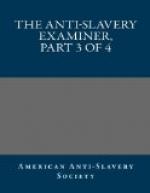“There was one plantation just opposite my father’s house in the suburbs of Huntsville, belonging to Judge Smith, formerly a Senator in Congress from South Carolina, now of Huntsville. The name of his overseer was Tune. I have often seen him flogging the slaves in the field, and have often heard their cries. Sometimes, too, I have met them with the tears streaming down their faces, and the marks of the whip, (’whelks,’) on their bare necks and shoulders. Tune was so severe in his treatment, that his employer dismissed him after two or three years, lest, it was said, he should kill off all the slaves. But he was immediately employed by another planter in the neighborhood. The following fact was stated to me by my brother, James M. Allan, now residing at Richmond, Henry county, Illinois, and clerk of the circuit and county courts. Tune became displeased with one of the women who was pregnant, he made her lay down over a log, with her face towards the ground, and beat her so unmercifully, that she was soon after delivered of a dead child.
“My brother also stated to me the following, which occurred near my father’s house, and within sight and hearing of the academy and public garden. Charles, a fine active negro, who belonged to a bricklayer in Huntsville, exchanged the burning sun of the brickyard to enjoy for a season the pleasant shade of an adjacent mountain. When his master got him back, he tied him by his hands so that his feet could just touch the ground—stripped off his clothes, took a paddle, bored full of holes, and paddled him leisurely all day long. It was two weeks before they could tell whether he would live or die. Neither of these cases attracted any particular notice in Huntsville.
“While I lived in Huntsville a slave was killed in the mountain near by. The circumstances were these. A white man (James Helton) hunting in the woods, suddenly came upon a black man, and commanded him to stop, the slave kept on running, Helton fired his rifle and the negro was killed.[5]
[Footnote 5: This murder was committed about twelve years since. At that time, James G. Birney, Esq., now Corresponding Secretary of the American Anti-Slavery Society was the Solicitor (prosecuting attorney) for that judicial district. His views and feelings upon the subject of slavery were, even at that period, in advance of the mass of slaveholders, and he determined if possible to bring the murderer to justice. He accordingly drew up an indictment and procured the finding of a true bill against Helton. Helton, meanwhile, moved over the line into the state of Tennessee, and such was the apathy of the community, individual effort proved unavailing; and though the murderer had gone no further than to an adjoining county (where perhaps he still resides) he was never brought to trial.—ED.]
“Mrs. Barr, wife of Rev. H. Barr of Carrollton, Illinois, formerly from Courtland, Alabama, told me last spring, that she has very often stopped her ears that she might not hear the screams of slaves who were under the lash, and that sometimes she has left her house, and retired to a place more distant, in order to get away from their agonizing cries.




